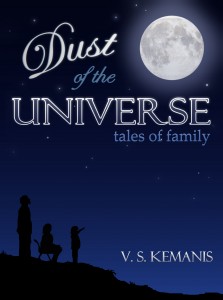 Reviewing self-published fiction can sometimes feel like a thankless task, even when you’re being paid for it. You can find yourself slogging through a book so woeful that you wonder how the author could possibly think it was ready for publication. Other times, you’ll be excited by a premise or intrigued by a character, but ultimately disappointed because the book doesn’t quite reach its mark. Then, there are those rare occasions when you find yourself in the hands of an author so unarguably gifted that your critical faculties are temporarily cut off. Within pages, you’ve slipped into the experience that all books promise but few deliver: you vanish for a few hours, disappearing into other places, other lives, and come out the other side thinking or crying or smiling – sometimes all three – and knowing more about the human experience than you did going in. Dust of the Universe is one of those rare books.
Reviewing self-published fiction can sometimes feel like a thankless task, even when you’re being paid for it. You can find yourself slogging through a book so woeful that you wonder how the author could possibly think it was ready for publication. Other times, you’ll be excited by a premise or intrigued by a character, but ultimately disappointed because the book doesn’t quite reach its mark. Then, there are those rare occasions when you find yourself in the hands of an author so unarguably gifted that your critical faculties are temporarily cut off. Within pages, you’ve slipped into the experience that all books promise but few deliver: you vanish for a few hours, disappearing into other places, other lives, and come out the other side thinking or crying or smiling – sometimes all three – and knowing more about the human experience than you did going in. Dust of the Universe is one of those rare books.
This is a wonderful collection, unrivaled in my reading of self-published short fiction and a delight by any standard. I read a lot of short stories, and count many short fiction specialists among my favorite writers. I’m going to have to make room on the upper shelves for V. S. Kemanis. There are stories here that I think I will remember forever. They’ve stayed with me in the weeks since I read them and make me smile even now as I call to mind their wonderfully flawed characters, their gentle humor, their twists and surprises and, without exception, the compassionate insight at their core.
Kemanis’ subject is family and she delivers everything that scope implies. There are recurrent themes of loss, separation, and the sadness of the unsaid. But there is joy here, too, and a good deal of warmth and humor. Kemanis draws on her own Latvian heritage and, presumably, her own experience as a lawyer and a mother. But this collection doesn’t feel limited or culturally specific. The writing moves easily between classes, cultures, times, ages, sexes and sexualities. The mainstay is a genuine fascination with people and our collective human struggle with this thing called “family”. There are stories about secretive aunts, jealous husbands, grieving sisters. One mother is afraid of losing her daughter, another imagines killing her own. There are frightened children, lost brothers, and several disappointed wives. But there are no judgements here. The characters judge each other mercilessly, of course, but they are presented without any implied judgement from the author. It’s enough to depict these people and their situations clearly for family to be revealed for what, if we live long enough, we discover it to be: a deep well of joy and sorrow, perhaps the greatest source of both.
There isn’t a weak story in this collection, I’d argue, but for me several stood out. In “Tidal Waters”, a mother’s anxiety about the inevitable loss of a close relationship with her adolescent daughter is played out in a drama-filled few days at the beach. The daughter, Becca, has brought along a friend, Carly, who with her sullen looks and dubious home life represents everything Becca’s mother, Pam, wants her daughter to avoid. The tension between allowing her daughter a measure of freedom and not wanting to relinquish the safety of parental control is exquisitely rendered as the story unfolds from Pam’s point of view. The balance tips when, on the second day, Carly promptly goes AWOL. In the anxious hours that follow, the relationship between Pam and her husband Gary is beautifully drawn. It’s an example of something Kemanis explores several times in this volume: the pattern of marriage; the inevitable frustration each person feels with the other, but also the deep love and understanding and the tiny signals that confirm it: “I’m sorry, Pam’s eyes said while his returned, no, I am, because that was their way in most things whenever the ground beneath them rumbled—to rush toward one another, open and changing, ready to settle once the tremor ceased.” This story sits comfortably beside two of my favorites, both about parental anxieties: “Learning to Swim” by Graham Swift and “An Anxious Man” by James Lasdun.
“Reckoning” is perhaps the most unexpected story in this collection. Arthur, the owner-operator of a self-storage business, is visited by Henry, an officious little IRS agent tasked with auditing his 2007 return. Arthur’s business is “an insignificant bit of nothing from a federal standpoint, merely enough to keep him alive while he pursues his passion, dreams his dreams, and massages his concept of reality onto the canvas of life.” Arthur is actually an artist, and sells his work secretly for money. While he sweats about the discovery of this untaxed secondary business he’s running behind the office door marked “Private”, he’s presented with an opportunity to open a private space of a different kind with Henry. Kemanis captures the burgeoning relationship between the two men beautifully, slowly revealing Arthur’s alienation from his family through the details of his tax affairs, and his artistic sensibility through his subtle observations of Henry.
There’s a lot of humor in these stories, and Kemanis uses it wisely. While no story is entirely comic, there are funny moments that usefully break the tension, or amusing premises that lay the groundwork for a more serious theme. In “A Love-Hate Thing”, a disgruntled wife masquerades as various professionals – musician, photographer, lawyer – in order to trick the men she encounters into confessing their lost dreams, their unlived lives, satisfying “the need that was buried under the accoutrements of maleness”. In “Schizophrenia Indicated”, a young widow reflects on the choice she made in marrying her late husband, an ambitious construction worker who got her pregnant, rather than the shy, grocery store bagger who loved her: “Now, sometimes she wondered. What would it have been like over the years, to be lowered gently to the bed like a bag of ripe tomatoes instead of hammered to the plank with a nail gun?” In “Like Love”, Harold, an art historian, is asked to believe that his wife is having a lesbian affair. “Our wives are cheating on us!” his fellow cuckold barks down the phone. Harold can scarcely believe it. And even if his Claire were engaged in a lesbian liaison, it could hardly be with the Nicole of his memory: “a large woman with a big red mouth and too much perfume”, not to mention her fingers – “big and long and distended like an ape’s.” But once the seed is planted, Harold cannot let it go. He comically endures a migraine to join Claire and Nicole for lunch, sniffing out signs of their duplicity. It’s a delightful study of a man unmanned by doubt, but Kemanis cleverly escalates it into a discussion about subjectivity and objectivity, too. It’s both funny and accomplished and would not be out of place in The New Yorker.
Only very occasionally does a story veer towards corny, e.g. the ending of “Conversation with a Biker” is a little too cute for my taste. That it happens so rarely as we navigate territory this emotionally fraught is almost miraculous. It would be so easy for stories on this theme to topple over into a cloying sweetness or for a moment of tragedy to feel laughably contrived. Two stories here walk that tightrope magnificently. “Lucky” deals with a mother’s hopes and fears for her disabled daughter and has, at the centre of it, a heart-stopping moment of suspense. But the one that does it best is the title story, “Dust of the Universe”. It’s one of the shortest stories in this collection, but to my mind it’s the best. It’s a very simple idea, superbly executed, that in the wrong hands could be absurdly twee. It’s also impossible to discuss it at any length without ruining it. Suffice it to say, it’s a gem: small, hard and beautiful. It breaks my heart every time.
It’s one of several stories in this collection that reminded me of what only prose fiction can do, or rather what prose fiction does best: the seamless weaving of past and present, the inner life and the outer lie, giving us the closest approximation of a character’s lived experience as it’s probably possible to make in art. Film and painting can give us staggering images. Music can move us, undoubtedly. An actor can communicate multitudes with the subtlest change in the body or the face. But only prose can take us inside the mind and heart of another human being and show us the world through their eyes. When it’s done right, it can be incredibly moving – and enlightening. In seeing things from another’s point of view, we often learn as much about ourselves. It’s a complex feat Kemanis pulls off repeatedly, and with apparent ease. That’s the sign of a great talent, and her book deserves to be very successful.
Links
Get an Editorial Review | Get Amazon Sales & Reviews | Get Edited | Publish Your Book | Enter the SPR Book Awards | Other Marketing Services






















Leave A Comment